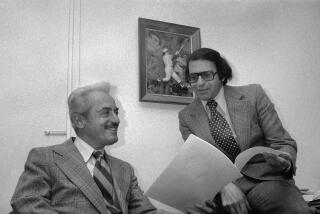Marvin Miller dies at 95; baseball union chief led push for free agency
Nothing about Marvin Miller seemed feisty or controversial at first glance; the soft-spoken economist was a smallish man with gray hair and a tidy mustache.
But as a union leader, it was Miller who took on baseballâs establishment in the late 1960s, eventually guiding players to an era of mega-salaries and free agency, thereby changing the landscape of American sports.
âNobody realized how gargantuan the task was,â he said years later. âMajor league players were, at the time, truly brainwashed.â
PHOTOS: Notable deaths of 2012
Miller died Tuesday at his home in Manhattan, several months after being diagnosed with liver cancer, his family announced. He was 95.
Historian Studs Terkel characterized him as âthe most effective union organizer since John L. Lewis,â the legendary mine workers leader. Hank Aaron, one of the gameâs most-prolific home run hitters, wrote that he âshould be in the Hall of Fame [even] if the players have to break down the doors to get him in.â
During Millerâs tenure as head of the Major League Baseball Players Assn. from 1966 to 1982, average salaries rose from $19,000 to $241,000, in large part because he fought baseballâs antitrust exemption and gave players the right to move from team to team.
âMarvin possessed a combination of integrity, intelligence, eloquence, courage and grace that is simply unmatched in my experience,â said Donald Fehr, who later headed the players union. âWithout question, Marvin had more positive influence over Major League Baseball than any other person in the last half of the 20th century.â
But not everyone appreciated Miller. As basketball and football subsequently adopted free agency, fans saw higher ticket prices, work stoppages and a new order in which favorite players often switched teams.
âYou may not like what he did,â said David Carter, executive director of USCâs Sports Business Institute, âbut you canât argue with how he did it.â
Before Millerâs arrival on the scene, owners dominated the sport. It came as a shock when Dodgers stars Sandy Koufax and Don Drysdale held out for more money in 1966, the team eventually signing them for $125,000 and $110,000, respectively.
That same spring, the ineffective players union went looking for a leader and was referred to Miller.
Born April 14, 1917, he had grown up in Brooklyn, and his fondest childhood memories included Dodgers games at Ebbets Field, a short subway ride from home.
Miller received an early education in trade unionism from his father, a garment district salesman who organized fellow workers. After graduating from New York University, he worked for the New York City welfare department before taking jobs as an economist with the War Production Board and the War Labor Board during World War II.
âIt was kind of like a utopian dream,â he said of the latter board, created to handle disputes between management and workers. âAnd it worked remarkably well.â
Miller subsequently moved to the United Steelworkers, where he spent 16 years as a research economist and, later, assistant to the president. In 1963, President Kennedy appointed him to a national labor management panel.
After the players union approached him, Miller made the rounds at spring training, facing opposition from wary players.
âThe club owners are saying that youâre one bad guy; theyâre saying terrible things about you,â he recalled hearing.
Miller told them: âIf I represent you and, at some point down the road, you begin to hear management people praising me, itâs time to fire me.â
Ultimately elected, Miller entered a domain that had yet to be influenced by multimillion-dollar contracts and billion-dollar television contracts. Players were paid relatively little and bound to their teams, moving from one to another only if traded.
The sportâs âreserve clauseâ was bolstered by a 1922 U.S. Supreme Court ruling that baseball was not a business and therefore not subject to federal antitrust laws. Baseball was â and still is â the only sport to enjoy such an exemption.
âThat turned people into property,â Miller said. âSo our struggle would center on that.â
The new union boss began by negotiating a raise in minimum salary â from $6,000 to $10,000 a season â and persuading owners to accept arbitration for disputes, a victory that would prove significant.
Occasionally portrayed as hard-edged, Miller more often relied on persistence and compromise. His late wife, Terry, told The Times: âOne of the things I get most impatient with Marvin about is his infinite patience.â He was also matched against baseball commissioners â first Spike Eckert, then Bowie Kuhn â perceived as less-skilled negotiators.
With salary issues resolved, Miller revisited players, preparing his constituency for a battle over the reserve clause that would be waged on several fronts.
In 1970, St. Louis Cardinals outfielder Curt Flood challenged the clause in court. Miller did not expect success â the U.S. Supreme Court eventually ruled against Flood â but considered it a first step and followed up with a 13-day strike in 1972.
Then, in 1974, Oakland Aâs owner Charles O. Finley neglected to pay an agreed-upon insurance policy for Jim âCatfishâ Hunter. The ace pitcher turned to arbitration â the process Miller had won for players â and became the gameâs first free agent, signing with the New York Yankees for $3.75 million over five years.
The final step came a year later, by way of an overlooked phrase in the standard contract. By Millerâs reading, it stated that if a playerâs contract expired and he did not sign a new one, his team could keep him for one more season under the old terms. The union boss interpreted this to mean the player then became a free agent.
In 1975, Andy Messersmith of the Dodgers and Dave McNally of the Montreal Expos tested the theory, playing unsigned. They subsequently won in arbitration, striking down the reserve clause. Baseball had entered a new age.
âI donât think it would have happened without him,â said Spencer Waller, co-author of âBaseball and the American Legal Mind.â âWhen [baseball] caved, that paved the way for all other sports.â
The NBA quickly adopted free agency, with the NFL following later. Miller led his players through one more strike in 1981 â lasting 50 days â before stepping down in 1982 to become a consultant.
Even in semi-retirement, he remained a lightning rod for criticism as fans grew increasingly disenchanted with skyrocketing player salaries. Upon the publication of his 1991 book, âA Whole Different Ball Game: The Inside Story of Baseballâs New Deal,â which characterized owners as boorish if not corrupt, critics labeled him as conceited.
Yet, the Sporting News ranked Miller as the fifth most-influential figure in 20th century sports and a new generation of players continued to benefit from his efforts. The leagueâs minimum salary is now $480,000 â 80 times the minimum pay when Miller took over the union.
âHe made a distinct impact on the sport, which is reflected in the state of the game today,â Commissioner Bud Selig said.
One place Miller has not earned respect is in baseballâs Hall of Fame. While former players such as Aaron and Joe Morgan have called for his election â pitcher Nolan Ryan even thanked him during a 1999 Hall of Fame acceptance speech â Miller has never garnered the necessary votes.
In a 2004 interview at his home on New Yorkâs Upper East Side, the former union leader â who is survived by son Peter, daughter Susan and a grandson â smiled at the idea of receiving support from an electorate that includes team and league executives. He did not expect a groundswell from fans, either.
âSure, it would mean a lot to me, but I never was holding my breath,â he said. âIâve been a trade unionist all my life and, as such, you learn early that youâre not to court popularity with either the management or the public.â
More to Read
Start your day right
Sign up for Essential California for the L.A. Times biggest news, features and recommendations in your inbox six days a week.
You may occasionally receive promotional content from the Los Angeles Times.







